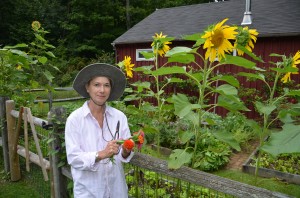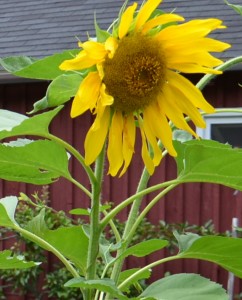 There is something innately happy about a sunflower. This is the time of year, just as the sun begins to cut back its regular working hours, that you see their big bright round faces leaning over fences and dotting backyard gardens across our region. If the chrome yellow of forsythia and daffodils presage the start of our all-too-short growing season, the golden yellow of sunflowers foreshadows its end. They’re one of summer’s final gifts — not just riotously pretty in centerpieces but seriously delicious and nutritional when harvested for their seeds.
There is something innately happy about a sunflower. This is the time of year, just as the sun begins to cut back its regular working hours, that you see their big bright round faces leaning over fences and dotting backyard gardens across our region. If the chrome yellow of forsythia and daffodils presage the start of our all-too-short growing season, the golden yellow of sunflowers foreshadows its end. They’re one of summer’s final gifts — not just riotously pretty in centerpieces but seriously delicious and nutritional when harvested for their seeds.
I started to grow sunflowers on a whim. I was picking out my vegetable seeds at Ward’s Nursery one April several years ago when I noticed a packet of Renee’s “Edible Snack Seed Sunflowers” that was advertised as having, “big flower faces and golden petals that mature into heavy heads of large, delicious, plump seed kernels.” It cost $2.29. How could I resist? I planted them along the split rail fence inside our vegetable garden and, just as promised, by the end of August the plants had shot up 7 feet high with heads the size of dinner plates packed with beautiful glossy black seeds. Then, something odd began to happen. The seeds started to disappear! They seemed to be popping out of the tightly-packed flower centers like loose buttons and ending up as shelled husks strewn across the vegetables beds.
 It didn’t take long to realize that the birds were dive-bombing down and devouring them. So I cut off the flower heads and set them out around the garden like so many snack bowls and let the birds feast away on the seeds to their hearts’ content. Every year since, I’ve grown them for the decorative value they add to the vegetable garden and the pleasure of watching them shoot up —sometimes as much as six inches in a single week — like teenagers in a growth spurt. Then, at summer’s end, I cut them down and offer the seeds to the birds who have serenaded us all summer and will soon be gone. Bees and butterflies also love sunflowers, so growing them enhances not just the beauty but the health of your garden.
It didn’t take long to realize that the birds were dive-bombing down and devouring them. So I cut off the flower heads and set them out around the garden like so many snack bowls and let the birds feast away on the seeds to their hearts’ content. Every year since, I’ve grown them for the decorative value they add to the vegetable garden and the pleasure of watching them shoot up —sometimes as much as six inches in a single week — like teenagers in a growth spurt. Then, at summer’s end, I cut them down and offer the seeds to the birds who have serenaded us all summer and will soon be gone. Bees and butterflies also love sunflowers, so growing them enhances not just the beauty but the health of your garden.
Not, I hope, that you’ll ever need to use them for this purpose, but sunflowers can also help extract toxic elements from the soil. Sunflowers were seeded at Chernobyl and, more recently, millions of them were planted at the Fukushima Daaichi nuclear site to help soak up nuclear radiation.
 Despite what I thought to be true most of my life, I learned recently that the faces of mature sunflowers don’t actually track the movement of the sun across the sky (known as heliotropism). This characteristic occurs only during the early bud stage, before the actual heads form, and by the end of that phase the plants have all turned eastward — and stay there. Whether growing in Provence or South Dakota, rows and rows of mature sunflowers are always facing east. There’s nothing quite as comforting as working in the garden early in the morning at the tag end of summer, surrounded by my tall strong, stalwart honor guard of sunflowers, their faces tilted uniformly upwards to greet the coming day.
Despite what I thought to be true most of my life, I learned recently that the faces of mature sunflowers don’t actually track the movement of the sun across the sky (known as heliotropism). This characteristic occurs only during the early bud stage, before the actual heads form, and by the end of that phase the plants have all turned eastward — and stay there. Whether growing in Provence or South Dakota, rows and rows of mature sunflowers are always facing east. There’s nothing quite as comforting as working in the garden early in the morning at the tag end of summer, surrounded by my tall strong, stalwart honor guard of sunflowers, their faces tilted uniformly upwards to greet the coming day.
Here’s a lovely poem by Mary Oliver (who obviously didn’t get the memo on heliotropism):
The Sunflowers Come with me into the field of sunflowers. Their faces are burnished disks, their dry spines creak like ship masts, their green leaves, so heavy and many, fill all day with the sticky sugars of the sun. Come with me to visit the sunflowers, they are shy but want to be friends; they have wonderful stories of when they were young – the important weather, the wandering crows. Don’t be afraid to ask them questions! Their bright faces, which follow the sun, will listen, and all those rows of seeds – each one a new life! hope for a deeper acquaintance; each of them, though it stands in a crowd of many, like a separate universe, is lonely, the long work of turning their lives into a celebration is not easy. Come and let us talk with those modest faces, the simple garments of leaves, the coarse roots in the earth so uprightly burning.
Tips for growing sunflowers:
• Not surprisingly, they need a lot of sun — at least 6 to 8 hours a day and even more if possible.
• They thrive on a big bed and breakfast — so give them plenty of room to grow (space seeds about 2 feet a part) and lots of compost and supplements. Warning: they do tend to suck nutrients (as well as toxins) out of the soil so be careful what you plant them near.
• They need support — that’s why I situate mine along the split rail fence and at the end of the season tie them to the fencing to keep them from toppling over in the wind and rain.
• Keep their heads covered. If you want to harvest the seeds for yourself, put a paper bag over the flowerheads once they have matured or the birds will make away with your bounty.
• You can purchase seeds at every good garden center, but for an excellent selection and more helpful growing information, check out the ever-reliable Renee’s Garden Seeds: https://www.reneesgarden.com.

